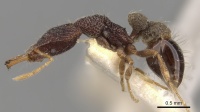Strumigenys lopotyle
| Strumigenys lopotyle | |
|---|---|

| |
| Scientific classification | |
| Kingdom: | Animalia |
| Phylum: | Arthropoda |
| Class: | Insecta |
| Order: | Hymenoptera |
| Family: | Formicidae |
| Subfamily: | Myrmicinae |
| Tribe: | Attini |
| Genus: | Strumigenys |
| Species: | S. lopotyle |
| Binomial name | |
| Strumigenys lopotyle Brown, 1969 | |
The few collections of this species were all from rainforest.
Identification
A member of the cygarix complex in the Strumigenys caniophanes-group.
Keys including this Species
Distribution
Latitudinal Distribution Pattern
Latitudinal Range: -6.733329773° to -8.767°.
| North Temperate |
North Subtropical |
Tropical | South Subtropical |
South Temperate |
- Source: AntMaps
Distribution based on Regional Taxon Lists
Indo-Australian Region: New Guinea.
Distribution based on AntMaps
Distribution based on AntWeb specimens
Check data from AntWeb
Countries Occupied
| Number of countries occupied by this species based on AntWiki Regional Taxon Lists. In general, fewer countries occupied indicates a narrower range, while more countries indicates a more widespread species. |

|
Estimated Abundance
| Relative abundance based on number of AntMaps records per species (this species within the purple bar). Fewer records (to the left) indicates a less abundant/encountered species while more records (to the right) indicates more abundant/encountered species. |

|
Biology
|
Castes
Nomenclature
The following information is derived from Barry Bolton's Online Catalogue of the Ants of the World.
- lopotyle. Strumigenys lopotyle Brown, 1969a: 27, figs. 1-3 (w.q.) NEW GUINEA. See also: Bolton, 2000: 760.
Unless otherwise noted the text for the remainder of this section is reported from the publication that includes the original description.
Description
Worker
Bolton (2000) - TL 2.8-3.3, HL 0.74-0.86, HW 0.65-0.77, CI 87-90, ML 0.34-0.39, MI 44-46, SL 0.40-0.49, SI 58-64, PW 0.38-0.45, AL 0.76-0.90 (5 measured).
Mandible with a small preapical tooth. Dorsolateral margin of head in full-face view with 5 or more freely laterally projecting short stiff simple hairs, each arising from a small tubercle; anteriormost hair just in front of level of eye, the posteriormost on margin of occipital lobe. Cephalic dorsum with a pair of erect hairs at highest point of vertex and a transverse row along occipital margin. Dorsum of head finely irregularly rugulose and also with punctate sculpture. Promesonotum mid-dorsally longitudinally rugose but on each side, and on side of pronotum, with narrow but deep foveolate pits that are bordered by smooth rugulae. Propodeal dorsum transversely rugulose anteriorly, punctate posteriorly. Pleurae and side of propodeum sculptured. Pronotal humeral hair long, filiform and simple. Dorsal alitrunk with sparse erect simple hairs and fine simple ground-pilosity. Waist segments and first gastral tergite with simple standing hairs. Dorsal (outer) surfaces of middle and hind tibiae and basitarsi with long erect freely projecting hairs. Bullae of femoral glands very large; on hind femur length of bulla is about 0.50 X maximum length of femur. Propodeal teeth very small, reduced to a pair of denticles. Petiole node in dorsal and lateral view, except for its near-vertical anterior face, completely concealed by a massive and continuous overgrowth of very fine dense spongiform tissue. Postpetiole similarly covered, with only a small anteromedian part of the disc visible. Basigastral costulae minute, shorter than width of limbus.
The huge overgrowths of spongiform tissue on the petiole and postpetiole render lopotyle unmistakable. In profile the petiole node appears to be wearing a tall spongiform bonnet. The lateral surface of the node proper is invisible, as is the dorsum except for the extreme anteromedian part at the top of the ascending anterior face. The postpetiole dorsally has equally dense spongiform tissue and only a small portion of the disc remains exposed.
Type Material
Bolton (2000) - Holotype worker, paratype workers and queen, PAPUA NEW GUINEA: Lae, Didiman Creek, 27.iii.1955, nos. 690, 702, 716, lowl. rainforest (E. O. Wilson) (Museum of Comparative Zoology, Australian National Insect Collection) [examined].
- Paratype, 3 workers, Didiman Creek, Lae, Papua New Guinea, Wilson,E.O., ANIC32-017705, Australian National Insect Collection.
References
- Bolton, B. 2000. The ant tribe Dacetini. Memoirs of the American Entomological Institute. 65:1-1028. (page 760, redescription of worker)
- Brown, W. L., Jr. 1969b. Strumigenys lopotyle species nov. Pilot Regist. Zool. Card No. 27. (page 27, worker, queen described)
- Tang, K. L., Guénard, B. 2023. Further additions to the knowledge of Strumigenys (Formicidae: Myrmicinae) within South East Asia, with the descriptions of 20 new species. European Journal of Taxonomy 907, 1–144 (doi:10.5852/ejt.2023.907.2327).
References based on Global Ant Biodiversity Informatics
- Bolton, B. 2000. The Ant Tribe Dacetini. Memoirs of the American Entomological Institute 65
- Brown W. L. J. 1969. Strumigenys lopotyle species nov. Pilot Register of Zoology. Card No. 27: 1-2.
- CSIRO Collection
- Janda M., G. D. Alpert, M. L. Borowiec, E. P. Economo, P. Klimes, E. Sarnat, and S. O. Shattuck. 2011. Cheklist of ants described and recorded from New Guinea and associated islands. Available on http://www.newguineants.org/. Accessed on 24th Feb. 2011.
- Room P. M. 1975. Diversity and organization of the ground foraging ant faunas of forest, grassland and tree crops in Papua Nez Guinea. Aust. J. Zool. 23: 71-89.

